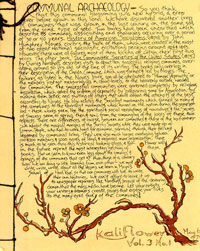Kaliflower
[ Vol. 3, No. 1, May 6, 1971]
Communal Archaeology
So you think that this communal blossoming is a new hybrid, a
crop never before grown in this land. We have discovered another
crop of communes that was grown in the last century, on the same
soil, from the same type of seed. Two books have been unearthed
which describe 85 communes, associations and phalanxes occuring
over a period of 30 or 40 years. History of American
Socialisms (1870), by John Humphrey Noyes, covers the bulk of
them, which were created in the midst of two great national
socialistic excitations peaking around 1826 & 1843. However,
these were all failures, most of them kicking off within their
first two years. The other book, The Communistic Societies of
the United States (1875), by Charles Nordhoff, describes
visits to about ten successful religious communes, averaging
around 50 yrs. old at the time of its writing. The books only
overlap in their description of the Oneida Commune, which was
formed & led by Noyes. The failures, as listed in the Noyes
book, can all be attributed to "Human Depravity," or
the members just not measuring up, in cloud-levels, the the
heavenly outlook needed for Communism. The successful communities
were governed completely by religious inspiration, which solved
the problem of depravity by "preparing some for Association
by making them better, and shutting off others that would defeat
the attempts of the best," according to Noyes. He also
relates the Socialist movements which formed so many of the
communes to the Revivalist movements which turned on the nation
during the same period — these waves seem like the spiritual
& social revolutions of nowadays, & the Secrets of Success
seem to spring, then & now, from the commingling of the
juices of these two aspects. There are differences, of course,
between our communes & those of the last century — we
inhabit the magical margins of the Surplus Society, while they
were made up of Common People, who had to work hard for economic
survival, though their toil was lessened by communal living. They
were also much larger, averaging between 100 & 200 members
& 1000 acres of land, & required more organization. There
is much to be seen thru this historical looking-glass, &
Kaliflower will in the future reprint the most interesting
sections of these books. But we seem to know even less about the
comings & goings of the communes that get KF than those of a
century ago. We are doing so little learning from each other — we must write, write, write about all the lessons we learn in
Maya's School of Hard Knox, so that our communes will live to
write their own histories. We can't afford to leave it up to
newspaper reporters like Nordhoff, because of the devouring demon
that the mass media have become. Let your artists, your writers
& dreamers create pages that expose your lives to the
many-eyed face of the communes!
|
 |

